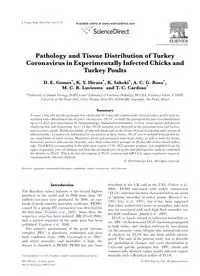
2010 Pathology and Tissue Distribution of Turkey Coronavirus in Experimentally Infected Chicks and Turkey Poults PDF
Preview 2010 Pathology and Tissue Distribution of Turkey Coronavirus in Experimentally Infected Chicks and Turkey Poults
Pathology and Tissue Distribution of Turkey Coronavirus in Experimentally Infected Chicks and Turkey Poults D. E. Gomes*, K. Y. Hirata*, K. Saheki*, A. C. G. Rosa*, M. C. R. Luvizotto† and T. C. Cardoso* *Laboratory of Animal Virology, DAPSA and †Laboratory of Veterinary Pathology, DCCRA, Veterinary School, UNESP, University of Sa˜o Paulo State, Clo´vis Pestana Street 793, 16.050-680, Arac¸atuba, Sa˜o Paulo, Brazil Summary Twenty 1-day-old specific pathogen free chicks and 20 1-day-old commercially derived turkey poults were in- oculated with a Brazilian strain of turkey coronavirus (TCoV) to study the pathogenicity and virus distribution up to 14 days post-inoculation by histopathology, immunohistochemistry, reverse transcriptase polymerase chain reaction and sequencing. At 2e14 dpi, TCoV antigens were detected in the paranasal sinus and lachry- mal accessory gland (Harderian gland) of infected chicks and in the ileum, ileocaecal junction and caecum of infected poults. Lymphocytic inflammation was present in these tissues. TCoV was re-isolated from pooled tis- sue suspensions of nasal concha, Harderian gland and paranasal sinus from chicks, as well as from the ileum, ileocaecal junction and caecum of poults, after three consecutive passages in 28-day-old embryonated turkey eggs. Viral RNA corresponding to the spike gene region (1178e2073 genome position) was amplified from the upper respiratory tract of chickens and from the intestinal tract of poults and phylogenetic analysis confirmed the identity as TCoV. This is the first description of TCoV antigens and mRNA in upper respiratory tissues in experimentally infected chickens. � 2010 Elsevier Ltd. All rights reserved. Keywords: apoptosis; immunohistochemistry; pathology; turkey coronavirus; viral infection Introduction The Brazilian turkey industry is the second highest producer in the world and in 2008 more than 187 million carcasses were produced. In 2006, an out- break of poult enteritis mortality syndrome (PEMS) caused by a group III coronavirus was detected for the first time (Teixeira et al., 2007). Since then, the respective virus has been isolated (BR/TCoV/2006) and a partial sequence of the spike gene has been published (Cardoso et al., 2008). The primary presentation of the poult enteritis complex (PEC) is diarrhoea, restlessness and poor body condition (Guy, 1998; Cavanagh et al., 2001) and where mortality and morbidity is high, the disease is classified as PEMS. PEMS has also been described in the UK and in the USA (Culver et al., 2006). PEMS associated with turkey coronavirus (TCoV) infection has been characterized as an excess or ‘spiking’ mortality of turkey poults (Brown et al., 1997; Guy et al., 1997), but it has been suggested that other undetected viruses or secondary infections may be associated with such high flock mortality un- der field conditions (Jindal et al., 2009). TCoV is closely related to infectious bronchitis vi- rus (IBV) of chickens and TCoV has been propagated in both turkey and chicken embryos by inoculation via the amniotic route. Despite this, natural infection of chickens by TCoV has not been widely investi- gated. The aim of the present study was to describe the pathological changes and virus distribution in 1-day-old specific pathogen free (SPF) chicks and commercially derived turkey poults infected experi- mentally with a Brazilian isolate of TCoV. Correspondence to: T.C. Cardoso (e-mail:
